If you’re about to go on your first snowshoe mission into wilderness, you’ll need to know what to wear snowshoeing. Getting your clothing right will help keep you warm, dry, and protected from the elements, which in turn will mean you have an even better time. You’ll also need to know how to do it if you’re a beginner. Read our guide to snowshoeing for more information.
In this article you’ll find suggestions on what to wear snowshoeing. You’ll also find information on what sort of fabrics to look for and their properties. If you are accustomed to hiking during the winter then you’ll already have a good idea of what to wear snowshoeing. Most of the clothing options are the same so you won’t need to go out and buy any specialist clothing. Likewise, if you already have clothing for snowboarding or skiing, then you’ll probably be covered
But for those who are new to the idea of getting out into the wild during snowy winter conditions, read on to see what to wear snowshoeing to stay warm, comfortable and protected.
- What shoes to wear snowshoeing
- What to wear snowshoeing
- What to look for when choosing clothing for snowshoeing
Disclaimer: We use affiliate links and may receive a small commission on purchases.
What shoes to wear snowshoeing
Winter boots are the ideal shoes to wear snowshoeing. They should be insulated with high tops, and good support. If you intend to get out snowshoeing regularly it will be well worth investing in a good pair, if you don’t already have some. However, for one-off or occasional snowshoeing excursions, a pair of sturdy, waterproof hiking boots do the job perfectly well.
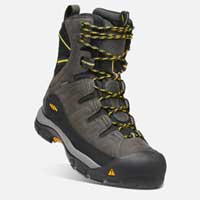
Winter boots
Properties: Waterproof, insulated, good grip, high tops
Fabric: Leather or synthetic with a waterproof membrane
Some great options to consider: Top winter hiking boots
Hiking boots
Properties: Waterproof, good grip, moderately stiff sole
Fabric: Leather or synthetic with a waterproof membrane
Some great options: Top hiking boots
What I wear: Scarpa SL Active Hiking Boots
What to wear snowshoeing

Thick socks
Properties: Warm, moisture wicking, odor resistant
Fabric: Merino/synthetic blend
Other features: Snowshoeing socks should be long enough to fit underneath your boots. If you wear long winter boots then ski socks can work well. Otherwise, long hiking socks are great.
Some great options: Our favourite hiking socks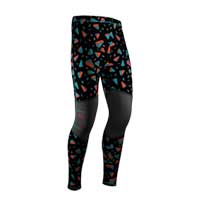
Long Johns
Properties: Moisture wicking, odor resistant, quick drying
Fabric: Merino or synthetic
Other info: Depending on the conditions, long johns aren’t always necessary, especially if your ski pants or outer pants are lightly insulated.
What I wear: So Solid Tights
Base layer top
Properties: Moisture wicking, odor resistant, quick drying
Fabric: Merino, synthetic or Polygiene treated synthetic
More info: Our favourite winter base layers
What I wear: Isobaa Merino 180 Long Sleeve Crew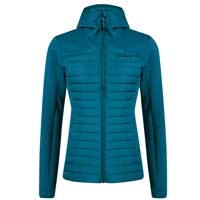
Mid layer
Properties: Insulating, breathable, durable, lightweight
Fabric: Synthetic fleece or down
More info: Our favourite winter mid layers
What I wear: Berghaus Nula Jacket
Jacket
Properties: Windproof, water-resistant, breathable, vents
Fabric: Synthetic
Other info: If you decide to wear a ski jacket that is lightly insulated then you may need to adjust your mid layer, opting for something less insulated, or foregoing one altogether. A waterproof jacket that has good breathability will work well, if you are able to layer well underneath it. The level of insulation you choose for your outer layer depends on the temperature and your own hiking preferences. Either way, a jacket with pit vents is a great way to help regulate temperature.
What I wear: Berghaus Extrem 5000 Vented Jacket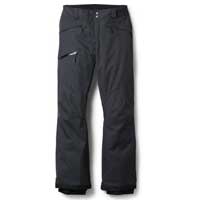
Pants
Properties: Water-resistant, windproof, breathable, durable, lightly insulated
Fabric: Synthetic
Other info: If you opt to wear ski pants then ones with zippered vents are excellent to help regulate your temperature. They are usually lightly insulated or have no insulation at all, but they are usually lined. Winter hiking pants also work well for snowshoeing.
What I wear: Columbia Wildside Snow Pants
Gloves
Properties:Breathable, waterproof, windproof, durable, warm
Fabric: Leather or synthetic with down or synthetic insulation
Other info: A nose wiper is always good, as well as the ability to clip them together. You may also want to consider two pairs of gloves for snowshoeing: a liner glove for when you are on the move and getting hot, and an insulated pair of gloves or mitts to put on when you stop or if bad weather moves in.
What I wear: Mammut Astro Guide Glove
Beanie hat or buff
Properties: Warm, moisture wicking, quick drying
Fabric: Merino, polyester fleece or synthetic
Other info: Your hat or buff should be thin enough to fit underneath a helmet without causing excess pressure on your head. But it needs enough insulation to keep you warm when not moving.
What I wear: Merino Buff
Sunglasses
Whether the sun’s out or not, you should always pack a pair of sunglasses, just in case. Even if there is light cloud cover, the snow can become very glary and sunglasses should be worn to protect your eyes. Ideally, the lenses should be polarised to protect against the glare of the snow as well as the damaging rays from the sun.
What I wear: Smith ChromoPop Shades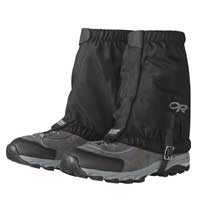
Gaiters
Though not essential, some snowshoers like to wear gaiters over the top of their pants and boots. These are especially helpful at preventing snow (and moisture) from creeping into the tops of your boots when snowshoeing in deep snow. As soon as snow gets into the tops of your boots, it will melt and seep into your socks. The result is soggy feet which can get cold very quickly and can also cause blisters.
More info and options: Hiking gaiters
Regardless of what you decide to wear on your first, or next snowshoeing mission, you should always pack an extra layer. An insulated jacket is ideal.
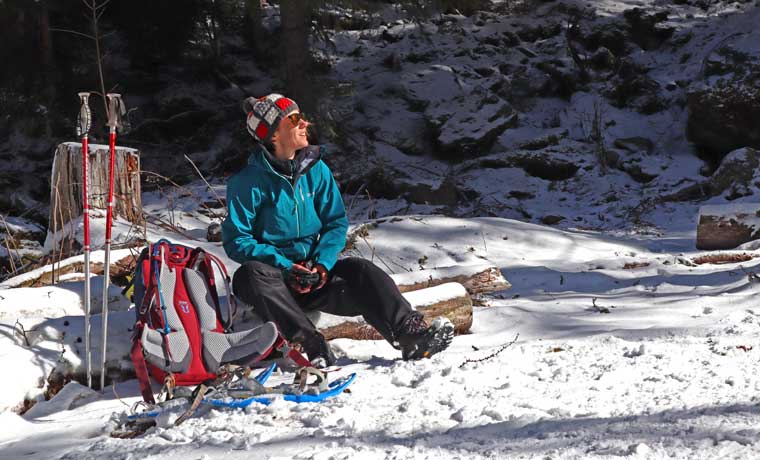
What to look for when choosing clothing for snowshoeing
Just like hiking at any time of the year, clothing for snowshoeing should be comfortable. If it doesn’t feel good and fit well then you’ll start to feel uncomfortable and grouchy very quickly.
Additionally, snowshoeing involves periods of exertion when your body temperature will be elevated. You’ll start to sweat and will want to shed all your layers. You’ll also have periods of inactivity to rest, look at wildlife or have a snack. During these times your body temperature can drop very quickly, especially if the air temperature is low. Getting your snowshoe clothing and knowing how to layer for snowshoeing will help you manage your temperature and prevent over or underheating.
The below factors will contribute to the overall comfort of your snowshoeing clothing.
01Fit
To ensure your snowshoeing clothing is as comfortable as possible, it should fit well. A good fit also ensures that it is thermally efficient.
Choose snowshoeing clothes that fit well:
- Outer layers should be loose-fitting — though not baggy. They shouldn’t cause any kind of restriction during movement and there should be enough room to comfortably wear layers underneath.
- Mid layers should be fitted but not tight — if they are too baggy they may cause a draft and create excess bulk underneath your outer layers. Too tight and they will cause restriction in movement.
- Base layers should be close-fitting — ensure that you get the right size for you, otherwise their close fit can cause restriction or chaffing. Base layer tops should also be long enough to tuck into your long johns or outer pants to prevent a draft at your midriff.
- All clothing for snowshoers should be the right size — pants that are too big at the waist can ride up, as can pants that are too small! Equally, layers that are ill-fitting can create gathering of excess fabric which can result in chaffing and discomfort.
Get the fit right and you’re halfway there to a highly comfortable set of clothing to hit the trails in.
02Fabric
Once you’ve got the fit right, the next thing to consider is the fabric of your snowshoe clothing. This can be a little more complex…
Each item of clothing you choose and need has a specific job to do, mostly determined by the fabric with which they are made.
The jobs of snowshoe clothes fabrics include:
- Temperature control – keeping you warm when you’re taking a break or when the wind and snow are beating down on you, but not so warm that you overheat when stomping uphill for prolonged periods.
- Moisture wicking – moving moisture (sweat) away from your skin. Base layers are great at this.
- Quick drying – if you sweat lots then your base layers need to dry out quickly to prevent the moisture from cooling on your body. Outer layers should also dry quickly if the snow is wet.
- Odour control – preventing the buildup of bacteria on your clothes
- Breathability – allows moisture vapour and air to move through the fabric.
- Waterproofing – preventing water from getting inside your clothing.
- Windproofing – stopping the wind from penetrating your clothing
Each of the above jobs, when done properly, contribute to the overall comfort of your clothes for snowshoeing.
03Types of fabric for snowshoe clothing
Synthetic fabrics (polyester, nylon or blends)
Good at: Drying quickly, moisture wicking, not holding water, water resistance
Bad at: Odour controlMerino wool
Good at: Moisture wicking, odour control, temperature regulation, providing warmth when wet, breathability
Bad at: Drying quickly, rinsing your bank account!Goose down
Good at: Keeping you really warm, packing down small, breathability
Bad at: Providing warmth when wet, waterproofing, drying quicklyPolyester fleece
Good at: Drying quickly, moisture wicking, not holding water
Bad at: Odour resistance
Don’t be put off by the volume of technical snowshoe clothing on our list. If you already spend time in the snow then it’s likely that you’ll have many of these items at the ready. The more you snowshoe, the more you’ll realise what you do and don’t need, and what to wear snowshoeing in different conditions.
Whatever snowshoeing clothes you do end up wearing, make sure they’ll protect you from the elements and provide comfort from the moment you put them on to the moment you take them off.
Happy snowshoeing, winter wanderers!



